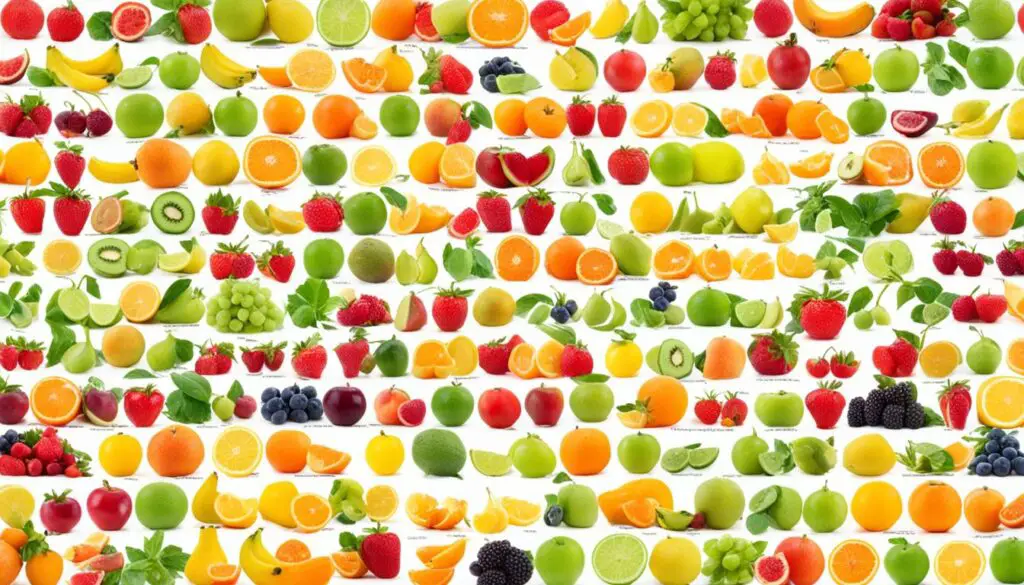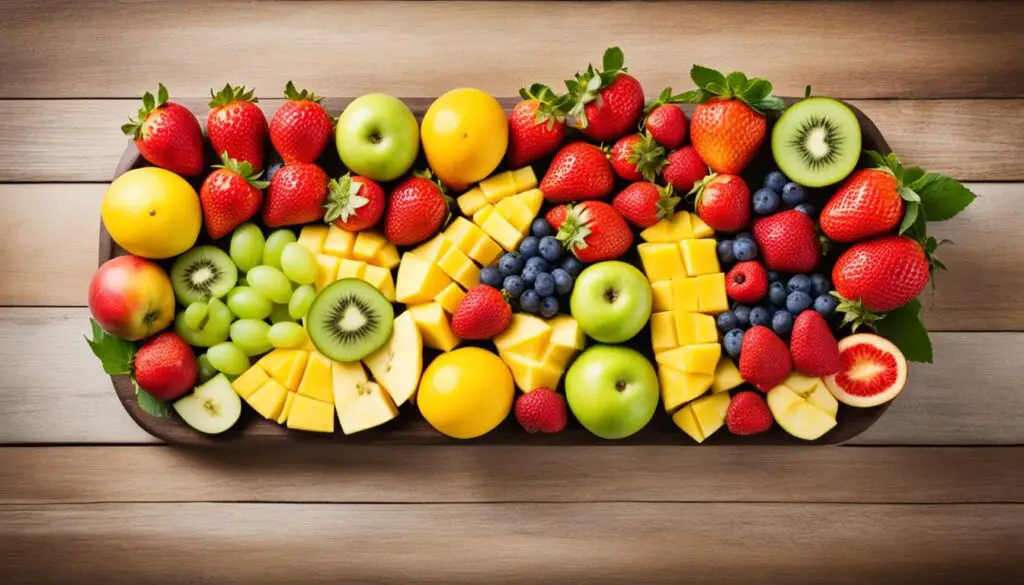Did you know that the HCG Diet Phase 3 allows for a variety of fruits to be consumed during the maintenance phase? This surprising fact reveals that you can still enjoy the natural sweetness of fruits while following the HCG diet. However, it’s important to choose wisely and opt for lower-sugar options to ensure continued weight management. Let’s explore the HCG Phase 3 approved fruits and learn how to incorporate them into your diet.
Key Takeaways:
- During the HCG maintenance phase, a variety of fruits can be consumed in moderation.
- Choose lower-sugar fruits like berries to minimize the impact on blood sugar levels.
- Avoid high-sugar fruits, dried fruits, and fruit juices during the maintenance phase.
- Fresh berries, apples, cherries, strawberries, and melons are some of the approved fruits on the HCG Phase 3.
- Portion control is essential when incorporating fruits into your HCG maintenance phase diet.
HCG Diet Phase 3 Approved Proteins and Dairy
During the HCG maintenance phase, you have a wide range of protein options to choose from. All animal proteins, such as chicken, beef, pork, and seafood, are allowed. You can also include eggs and dairy in your meals. It’s important to opt for whole, unprocessed protein sources to ensure you’re getting the most nutrients from your food.
If possible, choose organic, wild-caught, free-range, and grass-fed meats. These options are generally higher in quality and free from added hormones or antibiotics. They provide a healthier and more sustainable protein source for your diet.
For those following a vegetarian or vegan lifestyle, there are plant-based protein options available as well. Whey, pea, and rice protein powders are allowed during the HCG Phase 3. Make sure to choose brands that are sweetened with natural, sugar-free alternatives like stevia.
By incorporating these protein-rich foods into your meals, you can maintain a balanced diet during the HCG maintenance phase while still enjoying a wide variety of flavors and nutrients.
Sample Protein and Dairy Options:
| Proteins | Dairy |
|---|---|
| Chicken | Cheese |
| Beef | Half and Half |
| Pork | Whole Milk |
| Seafood | Cream |
| Eggs | Greek Yogurt (unsweetened, full-fat) |
Remember to choose quality protein sources and read labels to ensure your dairy products are unprocessed and unsweetened. By making thoughtful choices, you can optimize your protein intake and maintain a healthy and satisfying diet during the HCG maintenance phase.
HCG Diet Phase 3 Approved Vegetables

During the HCG Phase 3, you have a variety of vegetables to choose from to complement your diet. These non-starchy vegetables play a vital role in providing essential nutrients while keeping your calorie intake in check. Opt for colorful and nutrient-rich options to support your overall well-being.
Here is a list of approved vegetables:
| Vegetables | Glycemic Index (GI) Value |
|---|---|
| Lettuce | 8 |
| Greens | 15 |
| Peppers | 15 |
| Cauliflower | 15 |
| Broccoli | 15 |
| Cabbage | 15 |
| Carrots | 30 |
| Mushrooms | 10 |
| Sprouts | 15 |
| Radishes | 15 |
| Tomatoes | 15 |
| Onions | 10 |
| Garlic | 15 |
| Herbs | 5 |
| Brussel Sprouts | 15 |
| Cucumber | 15 |
| Asparagus | 15 |
| Avocados | 10 |
All other non-starchy vegetables are also approved. Remember to incorporate a variety of these vegetables into your meals to provide a balanced and nutritious diet.
HCG Diet Phase 3 Approved Fruits
During the HCG maintenance phase, all fruit is allowed in moderation. It is important to exercise caution with portions and choose lower-sugar fruits whenever possible to maintain the balance of the HCG diet. Fresh berries, such as strawberries, blueberries, raspberries, and blackberries, are excellent options due to their lower sugar content and high antioxidant levels.
Dried fruits and fruit juices should be avoided during the maintenance phase, as these tend to have higher sugar concentrations. Opt for whole, fresh fruits instead. Some examples of HCG Phase 3 approved fruits include:
- Apples
- Cherries
- Strawberries
- Blueberries
- Raspberries
- Blackberries
- Melons
- Kiwi
- Grapes
- Peaches
- Nectarines
- Apricots
- Pomegranates
These fruits provide a variety of flavors, textures, and nutrients, making them a delicious and nutritious addition to your HCG diet during the maintenance phase. Remember, bananas should be avoided until Phase 4.
Adding approved fruits to your HCG diet during the maintenance phase can help satisfy your sweet cravings while ensuring you stay on track with your weight management goals. Remember to enjoy them in moderation and listen to your body’s signals of fullness. By incorporating these fruits into your diet, you can maintain a well-rounded and balanced approach to healthy eating during the HCG maintenance phase.
HCG Diet Phase 3 Approved Oils and Fats

During the HCG maintenance phase, incorporating healthy oils and fats into your diet is allowed. It is important to choose quality options that provide essential nutrients and support overall well-being. Here are some approved oils and fats you can enjoy:
| Oil/Fat | Benefits |
|---|---|
| Coconut oil | Rich in medium-chain triglycerides (MCTs) that can boost metabolism and promote satiety. |
| Olive oil | Provides heart-healthy monounsaturated fats and antioxidant properties. |
| Real butter | Contains essential fatty acids and fat-soluble vitamins. |
| Nut and seed oils | A variety of nut and seed oils such as avocado oil, almond oil, hemp seed oil, and flaxseed oil can provide a range of nutrients. |
When selecting oils and fats for cooking or dressing, it is crucial to avoid trans fats and artificial products like margarine and Crisco. These unhealthy options can increase inflammation and negatively impact your health. Instead, opt for natural, unprocessed oils and fats.
Choose healthy fats whenever possible and read labels to avoid processed or unhealthy options.
By incorporating these approved oils and fats into your HCG maintenance phase, you can add flavor and richness to your meals while still maintaining a healthy eating plan.
Summary
In the HCG maintenance phase, utilizing oils and fats in your meals is permitted. Coconut oil, olive oil, real butter, and various nut and seed oils are all approved options that provide essential nutrients and contribute to a well-rounded diet. Remember to choose healthy fats, avoid processed alternatives, and enjoy the flavors these oils and fats bring to your meals.
HCG Diet Phase 3 Approved Nuts and Seeds
During the HCG Phase 3, you have the option to enjoy a variety of nuts and seeds, although it’s important to consume them in moderation. Some nuts and seeds contain higher levels of starch, so it’s recommended to exercise caution when including them in your diet. Here are the approved nuts and seeds for the HCG maintenance phase:
| Approved Nuts | Approved Seeds |
|---|---|
| Almonds | Chia Seeds |
| Walnuts | Pumpkin Seeds |
| Peanuts | Sesame Seeds |
| Pecans | |
| Coconut | |
| Hazelnuts | |
| Pistachios |
Certain nuts and seeds like cashews, pignoles (pine nuts), and sunflower seeds should be consumed with extra caution due to their higher starch content. It’s always a good idea to consult with your healthcare provider or nutritionist to determine the best portion sizes and ensure they fit within your overall dietary plan.
Remember to balance your nut and seed intake with other food groups and choose natural, unsalted varieties whenever possible. Incorporating a variety of approved nuts and seeds can add flavor, texture, and healthy fats to your meals while providing essential nutrients.
Expert Tip: Incorporating Nuts and Seeds
I recommend adding a sprinkle of chia seeds to your morning yogurt or blending them into a delicious smoothie. For an afternoon snack, grab a small handful of almonds or walnuts and pair them with a piece of approved fruit for a balanced and satisfying treat.
By including these approved nuts and seeds in your HCG Phase 3 diet, you can enjoy added nutrition and variety while maintaining the principles of the maintenance phase. Remember to practice portion control and make informed choices to support your overall well-being.
HCG Diet Phase 3 Approved Dairy

During the HCG maintenance phase, incorporating dairy products into your diet is allowed. However, it is important to make mindful choices in order to support weight stabilization. It is recommended to avoid skim or low-fat dairy products as they may interfere with this process. Instead, opt for full-fat dairy options that are unprocessed and unsweetened.
Some examples of HCG maintenance phase approved dairy include:
- Unprocessed cheeses
- Half and half
- Whole milk
- Cream
- Unsweetened full-fat Greek yogurt
By choosing high-quality dairy products and avoiding processed or artificial cheese alternatives, you can enjoy the benefits of dairy while adhering to the guidelines of the HCG maintenance phase. These dairy options not only contribute to the variety of your diet, but they also provide essential nutrients like calcium and protein.
“Incorporating full-fat dairy products into your diet can support weight stabilization during the HCG maintenance phase.”
As always, it is important to listen to your body and adjust your food choices based on your specific needs. Monitoring your progress and consulting with a healthcare professional can provide further guidance during this phase of the HCG diet.
HCG Maintenance Phase Guidelines and Recommendations

During the HCG maintenance phase, it is crucial to follow certain guidelines and recommendations to ensure a successful transition and weight management. Here are some key practices to consider:
Weigh Yourself Regularly
Monitoring your progress is essential during the HCG maintenance phase. Weigh yourself every morning to keep track of your weight and any fluctuations that may occur. This will help you identify any trends and make necessary adjustments to your diet and exercise routine.
Avoid Sugar and Starches
For the first three weeks of the maintenance phase, it is recommended to steer clear of foods high in sugar and starches. This will assist in stabilizing your weight and preventing any potential setbacks. Instead, focus on consuming nutrient-dense foods and natural sources of carbohydrates.
Gradually Reintroduce Sugar and Starches
After the initial three weeks, you can slowly reintroduce sugar and starches back into your diet. However, it is crucial to do so in small quantities and be mindful of portion sizes. Gradual reintroduction allows you to assess how your body responds and make adjustments accordingly.
Keep a Journal
A journal can be a useful tool during the HCG maintenance phase. Record your daily food intake, including the fruits, proteins, vegetables, and other permissible foods you consume. Additionally, note any changes in weight or body measurements. This will help you track your progress and identify any patterns or triggers that may impact your weight management.
Reintroduce Exercise
Exercise is an important component of a healthy lifestyle, even during the HCG maintenance phase. Gradually reintroduce physical activity into your routine, taking into consideration any limitations or modifications recommended by your healthcare provider. Regular exercise will help improve your overall fitness, support weight maintenance, and enhance your overall well-being.
| Guidelines | Recommendations |
|---|---|
| Monitor your weight regularly | Weigh yourself every morning to track your progress |
| Avoid high sugar and starchy foods | Focusing on nutrient-dense options |
| Gradually reintroduce sugar and starches | In small quantities and monitor your body’s response |
| Keep a food and weight journal | Record your daily intake and changes in weight or body measurements |
| Reintroduce exercise | Gradually incorporate physical activity into your routine |
By following these guidelines and recommendations, you can effectively navigate the HCG maintenance phase and achieve your weight management goals. Remember to consult with your healthcare provider for personalized advice and support throughout this process.
Conclusion
During the HCG maintenance phase, a variety of fruits can be consumed in moderation. It is important to choose lower-sugar options and exercise caution with portions to maintain weight management. In addition to fruits, proteins, vegetables, oils and fats, nuts and seeds, and dairy are also allowed during this phase. By following the guidelines and monitoring weight, individuals can successfully navigate the HCG Maintenance Phase and continue their healthy lifestyle.
Choosing the right fruits during the maintenance phase is crucial for successful weight management. Opt for lower-sugar options like berries, cherries, and apples, while avoiding high-sugar fruits. Remember to consume fruits in moderation and focus on a balanced diet that includes proteins, vegetables, and other approved food groups.
Managing weight during the maintenance phase requires diligence and discipline. By carefully selecting the allowable fruits and incorporating them into a well-rounded diet, individuals can ensure continued success in their weight loss journey. Monitor portion sizes, follow the guidelines, and make informed choices to maintain a healthy lifestyle even after completing the HCG diet.
FAQ
What fruits are allowed during the HCG maintenance phase?
During the HCG maintenance phase, all fruits are allowed in moderation. It is recommended to choose lower-sugar options and exercise caution with portions. Some examples of HCG Phase 3 approved fruits include apples, cherries, strawberries, blueberries, raspberries, blackberries, melons, kiwi, grapes, peaches, nectarines, apricots, and pomegranates. Bananas should be avoided until Phase 4.
What proteins and dairy are allowed during the HCG maintenance phase?
The HCG maintenance phase allows for a variety of proteins and dairy. You can enjoy all animal proteins, eggs, and dairy. Choose whole, unprocessed protein sources such as organic, wild caught, free-range, and grass-fed meats. Whey, pea, and rice protein powders sweetened with natural, sugar-free sweeteners like stevia are also allowed. For dairy, opt for unprocessed, unsweetened cheeses, half and half, whole milk, cream, and unsweetened full-fat Greek yogurt. Avoid skim or low-fat dairy as they may interfere with weight stabilization.
What vegetables are allowed on the HCG maintenance phase?
During the HCG maintenance phase, a variety of non-starchy vegetables are allowed. Choose colorful, nutrient-rich options and vary your diet. Some approved vegetables include lettuce, greens, peppers, cauliflower, broccoli, cabbage, carrots, mushrooms, sprouts, radishes, tomatoes, onions, garlic, herbs, brussel sprouts, cucumber, asparagus, and avocados. All other non-starchy vegetables are also permitted.
Can I cook with oils and fats during the HCG maintenance phase?
Yes, you are allowed to cook with oils and fats during the HCG maintenance phase. Coconut oil, olive oil, real butter, and various nut and seed oils are permitted. It is important to avoid trans fats and artificial products like margarine and Crisco. Choose healthy fats whenever possible and read labels to avoid processed or unhealthy options.
Are nuts and seeds allowed on the HCG maintenance phase?
Yes, many nuts and seeds are allowed in moderation on the HCG Phase 3. However, some varieties have a higher starch content and should be consumed with caution. Approved nuts and seeds include almonds, walnuts, peanuts, pecans, coconut, hazelnuts, pistachios, and chia seeds. Cashews, sesame seeds, pignoles (pine nuts), and sunflower seeds should be consumed with extra caution due to their higher starch content.
Can I consume dairy during the HCG maintenance phase?
Yes, most full-fat dairy products are allowed during the HCG maintenance phase. It is recommended to avoid skim or low-fat dairy as they may interfere with weight stabilization. Choose unprocessed, unsweetened cheeses, half and half, whole milk, cream, and unsweetened full-fat Greek yogurt. Processed and artificial cheese products should be avoided.
Are there any guidelines or recommendations for the HCG maintenance phase?
Yes, during the HCG maintenance phase, it is important to weigh yourself every morning to monitor your progress. It is recommended to avoid sugar and starches for the first three weeks, gradually introducing them back in small quantities during the second three weeks. Keep a journal to track your weight and food intake. It is also advisable to reintroduce exercise during this phase.




